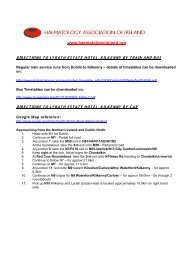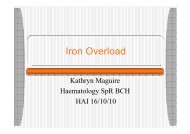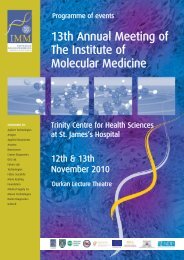Guidelines on Diagnosis and Treatment of Malignant Lymphomas
Guidelines on Diagnosis and Treatment of Malignant Lymphomas
Guidelines on Diagnosis and Treatment of Malignant Lymphomas
Create successful ePaper yourself
Turn your PDF publications into a flip-book with our unique Google optimized e-Paper software.
Mature B-Cell Neoplasms<br />
Chr<strong>on</strong>ic Lymphocytic Leukaemia/<br />
Small Lymphocytic Lymphoma<br />
Definiti<strong>on</strong> <strong>and</strong> Incidence:<br />
Chr<strong>on</strong>ic lymphocytic leukaemia / small lymphocytic lymphoma<br />
(CLL/SLL) is a neoplasm <strong>of</strong> m<strong>on</strong>omorphic small, round<br />
B- lymphocytes in the peripheral blood, b<strong>on</strong>e marrow <strong>and</strong> lymph<br />
nodes admixed with prolymphocytes <strong>and</strong> para-immunoblasts<br />
expressing CD5 <strong>and</strong> CD23. The term SLL is restricted to cases<br />
with the tissue morphology <strong>and</strong> immunophenotype <strong>of</strong> CLL but<br />
without a leukaemic comp<strong>on</strong>ent. CLL comprises 90% <strong>of</strong> chr<strong>on</strong>ic<br />
leukaemias in the USA <strong>and</strong> Europe <strong>and</strong> 7% <strong>of</strong> NHLs present as<br />
CLL/SLL. The majority <strong>of</strong> patients are >50 years old (median<br />
age 65) <strong>and</strong> the M: F ratio is 2:1. The incidence is 0.72cases<br />
/100,000 per year.<br />
ICD – O Codes: CLL 9823/3<br />
B-SLL 9670/3<br />
Clinical presentati<strong>on</strong><br />
Most patients with CLL are asymptomatic <strong>and</strong> the disease is<br />
diagnosed incidentally <strong>on</strong> routine full blood count. Presenting<br />
features can include lymphadenopathy, fatigue, auto-immune<br />
haemolytic anaemia, infecti<strong>on</strong>, or evidence <strong>of</strong> b<strong>on</strong>e marrow failure.<br />
Pathology<br />
The lymphoid infiltrate effaces normal lymphoid architecture<br />
with a pseudo-follicular pattern <strong>of</strong> regularly distributed<br />
pale areas c<strong>on</strong>taining larger cells in a dark background <strong>of</strong> small<br />
cells The cells are slightly larger than normal lymphocytes, have<br />
a high nuclear-cytoplasmic ratio, round nucleus <strong>and</strong> occasi<strong>on</strong>al<br />
small nucleolus. The pseud<strong>of</strong>ollicles c<strong>on</strong>tain a c<strong>on</strong>tinuum <strong>of</strong><br />
small, medium <strong>and</strong> large cells i.e. lymphocytes, prolymphocytes<br />
<strong>and</strong> para-immunoblasts. The size <strong>of</strong> the pseud<strong>of</strong>ollicles <strong>and</strong><br />
the number <strong>of</strong> para-immunoblasts vary but there is no<br />
well-documented correlati<strong>on</strong> between histological findings<br />
<strong>and</strong> clinical outcome.<br />
Cell morphology can vary <strong>and</strong> may be c<strong>on</strong>fused with mantle cell<br />
lymphoma (MCL). Plamacytoid differentiati<strong>on</strong> may also be present.<br />
In the blood <strong>and</strong> b<strong>on</strong>e marrow similar small lymphocytes are<br />
found <strong>and</strong> smudge, smear or basket cells are typically seen <strong>on</strong><br />
blood films. Prolymphocytes, which are larger cells with a<br />
prominent nucleolus, usually account for
















